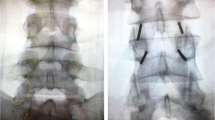Abstract
Background and aims
Radiofrequency denervation (RF) of the lumbar facet joints has been shown to be effective in well-selected patients. However, long-term success varies between studies. We evaluated the influence of selected psychosocial and constitutional factors on the outcome of RF, expressed as the duration of pain relief.
Methods
This prospective observational study included 44 patients who received RF denervations at the University Hospital of Berne. Success was defined as at least 50% pain reduction 7–21 days, 6 months and 1 year after RF therapy. The Cox-regression analysis was performed to evaluate the influence of the following factors on the duration of success: age, sex, depression, work inability and previous surgery.
Results
Complete follow-up was available for 41 patients. The success rate 7–21 days after the denervation was 76%. It decreased to 32% at 6 months and to 22% at 1 year. The median success duration was 17 weeks (95% CI 10–26). The Cox-regression analysis showed a significant shorter duration of success for patients with depression (hazard ratio [HR] 2.97, 95% CI 1.32–6.65), previous surgery (HR 2.39, 95% CI 1.10–5.21) and number of treated joints (HR 1.95 for each increase in the number of joints, 95% CI 1.14–3.33). In bivariate analyses, only depression was kept to be significant.
Conclusions
Depression seems to be related with a short duration of success. Based on these findings, a comprehensive study is warranted to evaluate whether psychosocial factors have to be considered when recruiting patients for radiofrequency denervation.


Similar content being viewed by others
References
Cohen SP, Raja SN (2007) Pathogenesis, diagnosis, and treatment of lumbar zygapophysial (facet) joint pain. Anesthesiology 106:591–614
Schwarzer AC, Aprill CN, Derby R, Fortin J, Kine G, Bogduk N (1994) Clinical features of patients with pain stemming from the lumbar zygapophysial joints. Is the lumbar facet syndrome a clinical entity? Spine 19:1132–1137
van Kleef M, Vanelderen P, Cohen SP, Lataster A, Van Zundert J, Mekhail N (2010) 12. Pain originating from the lumbar facet joints. Pain Pract 10:459–469. doi:10.1111/j.1533-2500.2010.00393.x
Boswell MV, Colson JD, Sehgal N, Dunbar EE, Epter R (2007) A systematic review of therapeutic facet joint interventions in chronic spinal pain. Pain Physician 10:229–253
Bogduk N, Dreyfuss P, Govind J (2009) A narrative review of lumbar medial branch neurotomy for the treatment of back pain. Pain Med 10:1035–1045. doi:10.1111/j.1526-4637.2009.00692.x
van Wijk RM, Geurts JW, Lousberg R, Wynne HJ, Hammink E, Knape JT, Groen GJ (2008) Psychological predictors of substantial pain reduction after minimally invasive radiofrequency and injection treatments for chronic low back pain. Pain Med 9:212–221. doi:10.1111/j.1526-4637.2007.00367.x
Dreyfuss P, Halbrook B, Pauza K, Joshi A, McLarty J, Bogduk N (2000) Efficacy and validity of radiofrequency neurotomy for chronic lumbar zygapophysial joint pain. Spine 25:1270–1277
Curatolo M, Bogduk N (2010) Diagnostic and therapeutic nerve blocks. In: Fishman SM, Ballantyne JC, Rathnell JP (eds) Bonica’s management of pain. Wolters Kluwer/Lippincott Williams & Wilkins, Philadelphia, pp 1401–1423
International Spine Intervention Society (2004) Lumbar medial neurotomy. In: Bogduk N (ed) Practice guidelines—spinal diagnostic and treatment procedures. International Spine Intervention Society, San Francisco, pp 188–218
Hautzinger M (1991) The Beck Depression Inventory in clinical practice. Nervenarzt 62:689–696
Prentice RL, Williams BJ, Peterson AV (1981) On the regression analysis of multivariate failure time data. Biometrika 68:373–379
Gofeld M, Jitendra J, Faclier G (2007) Radiofrequency denervation of the lumbar zygapophysial joints: 10-year prospective clinical audit. Pain Physician 10:291–300
van Kleef M, Barendse GA, Kessels A, Voets HM, Weber WE, de Lange S (1999) Randomized trial of radiofrequency lumbar facet denervation for chronic low back pain. Spine 24:1937–1942
Henschke N, Kuijpers T, Rubinstein SM, van Middelkoop M, Ostelo R, Verhagen A, Koes BW, van Tulder MW (2010) Injection therapy and denervation procedures for chronic low-back pain: a systematic review. Eur Spine J 19:1425–1449. doi:10.1007/s00586-010-1411-0
Bogduk N, Macintosh J, Marsland A (1987) Technical limitations to the efficacy of radiofrequency neurotomy for spinal pain. Neurosurgery 20:529–535
Wasan AD, Jamison RN, Pham L, Tipirneni N, Nedeljkovic SS, Katz JN (2009) Psychopathology predicts the outcome of medial branch blocks with corticosteroid for chronic axial low back or cervical pain: a prospective cohort study. BMC Musculoskelet Disord 10:22. doi:10.1186/1471-2474-10-22
Bingel U, Tracey I (2008) Imaging CNS modulation of pain in humans. Physiology (Bethesda) 23:371–380. doi:10.1152/physiol.00024.2008
Schweinhardt P, Kalk N, Wartolowska K, Chessell I, Wordsworth P, Tracey I (2008) Investigation into the neural correlates of emotional augmentation of clinical pain. Neuroimage 40:759–766. doi:10.1016/j.neuroimage.2007.12.016
Cohen SP, Hurley RW, Christo PJ, Winkley J, Mohiuddin MM, Stojanovic MP (2007) Clinical predictors of success and failure for lumbar facet radiofrequency denervation. Clin J Pain Vol 23:45–52
van Wijk RM, Geurts JW, Wynne HJ, Hammink E, Buskens E, Lousberg R, Knape JT, Groen GJ (2005) Radiofrequency denervation of lumbar facet joints in the treatment of chronic low back pain: a randomized, double-blind, sham lesion-controlled trial. Clin J Pain 21:335–344
North RB, Han M, Zahurak M, Kidd DH (1994) Radiofrequency lumbar facet denervation: analysis of prognostic factors. Pain 57:77–83. doi:0304-3959(94)90110-4
Pevsner Y, Shabat S, Catz A, Folman Y, Gepstein R (2003) The role of radiofrequency in the treatment of mechanical pain of spinal origin. Eur Spine J 12:602–605. doi:10.1007/s00586-003-0605-0
Conflict of interest
None.
Author information
Authors and Affiliations
Corresponding author
Rights and permissions
About this article
Cite this article
Streitberger, K., Müller, T., Eichenberger, U. et al. Factors determining the success of radiofrequency denervation in lumbar facet joint pain: a prospective study. Eur Spine J 20, 2160–2165 (2011). https://doi.org/10.1007/s00586-011-1891-6
Received:
Revised:
Accepted:
Published:
Issue Date:
DOI: https://doi.org/10.1007/s00586-011-1891-6




